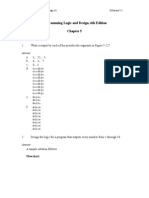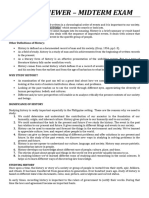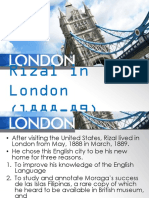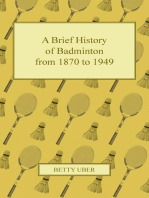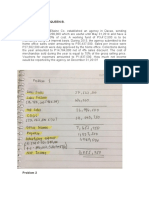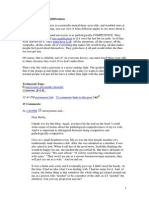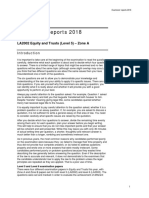0 ratings0% found this document useful (0 votes)
299 viewsSummary
Summary
Uploaded by
Meleen TadenaThis document provides an overview of historical criticism and its goals and methods. It discusses:
1. The goals of historical criticism are to discover the original meaning of texts in their historical context and reconstruct the historical situation of authors and recipients.
2. Methods include external criticism to authenticate sources and internal criticism to evaluate the trustworthiness of statements. External criticism examines paleography, provenance, and anachronisms. Internal criticism weighs the testimony and probability of statements.
3. Historical criticism aims to determine if sources are authentic through careful examination from various angles, as forgery was common. Skillful analysis of style, references, and details can detect fakes. Provenance also impacts judgments of genuineness
Copyright:
© All Rights Reserved
Available Formats
Download as DOCX, PDF, TXT or read online from Scribd
Summary
Summary
Uploaded by
Meleen Tadena0 ratings0% found this document useful (0 votes)
299 views3 pagesThis document provides an overview of historical criticism and its goals and methods. It discusses:
1. The goals of historical criticism are to discover the original meaning of texts in their historical context and reconstruct the historical situation of authors and recipients.
2. Methods include external criticism to authenticate sources and internal criticism to evaluate the trustworthiness of statements. External criticism examines paleography, provenance, and anachronisms. Internal criticism weighs the testimony and probability of statements.
3. Historical criticism aims to determine if sources are authentic through careful examination from various angles, as forgery was common. Skillful analysis of style, references, and details can detect fakes. Provenance also impacts judgments of genuineness
Original Title
summary.docx
Copyright
© © All Rights Reserved
Available Formats
DOCX, PDF, TXT or read online from Scribd
Share this document
Did you find this document useful?
Is this content inappropriate?
This document provides an overview of historical criticism and its goals and methods. It discusses:
1. The goals of historical criticism are to discover the original meaning of texts in their historical context and reconstruct the historical situation of authors and recipients.
2. Methods include external criticism to authenticate sources and internal criticism to evaluate the trustworthiness of statements. External criticism examines paleography, provenance, and anachronisms. Internal criticism weighs the testimony and probability of statements.
3. Historical criticism aims to determine if sources are authentic through careful examination from various angles, as forgery was common. Skillful analysis of style, references, and details can detect fakes. Provenance also impacts judgments of genuineness
Copyright:
© All Rights Reserved
Available Formats
Download as DOCX, PDF, TXT or read online from Scribd
Download as docx, pdf, or txt
0 ratings0% found this document useful (0 votes)
299 views3 pagesSummary
Summary
Uploaded by
Meleen TadenaThis document provides an overview of historical criticism and its goals and methods. It discusses:
1. The goals of historical criticism are to discover the original meaning of texts in their historical context and reconstruct the historical situation of authors and recipients.
2. Methods include external criticism to authenticate sources and internal criticism to evaluate the trustworthiness of statements. External criticism examines paleography, provenance, and anachronisms. Internal criticism weighs the testimony and probability of statements.
3. Historical criticism aims to determine if sources are authentic through careful examination from various angles, as forgery was common. Skillful analysis of style, references, and details can detect fakes. Provenance also impacts judgments of genuineness
Copyright:
© All Rights Reserved
Available Formats
Download as DOCX, PDF, TXT or read online from Scribd
Download as docx, pdf, or txt
You are on page 1of 3
LESSON 1 Historical Data- are sourced from the artifacts
HISTORY that have been left by the past.
-“historia” = Greek word, learning by inquiry - Relics of remains or the testimonies of
- Aristotle- systematic accounting of a set of witnesses
natural phenomena - A source is an object from the past or a
-knowledge is derived through conducting a testimony concerning the past on which
process of scientific investigation of past events historian depend to create their own
depiction of the past.
2 theories of investigating history - Ex. Relics (potsherd, coin, ruin,
- Factual history- present readers the manuscript, book, portrait, stamp etc.)
plain and basic information (what, - Testimonies of witnesses, whether oral
when, who) or written
- Speculative history-goes beyond facts ( Ex. Record of the property exchange,
why and how) speeches, commentaries
-cause and effect of the event
Historians- people who studies or write about Historian deal with the following:
history -Dynamic or genetic- the becoming
Historiography- the practice of historical -Static- the being
writing, traditional method in doing historical -Interpretative- explains why and how it
research happened
-Descriptive- tell what, when, who,
The limitations of Historical knowledge where it happened
-History-as-actuality- whole history of the past
-history-as-record- history through surviving Written sources of history
records 1. Narrative or literature –
-“incompleteness” of the “object” that historian chronicles or tracts presented
studies in narrative form
- Scientific tract- typically composed in
History as the subjective process of re-creation order to inform contemporaries
-Verisimilitude- the aim of the historian - Newspaper –may shape opinion
Means the truth, authenticity, plausibility - Ego document or personal narrative –
(memoir) to persuade readers
Historical method and historiography - Novel or film- to entertain, to deliver
-Historical method- the process of critically moral teachings
examining and analyzing the records and - Biography- in praise of the subject’s
survival of the past worth and achievements
- Panegyric – a public speech or
-Historiography- the imaginative construction of published text
the past from the data derived by that process - Hagiography- the writing of the lives of
the saints
-Historical analysis- a. select the subject to 2. Diplomatic sources- those
investigate, b. collect probable sources of which document/record an
information on the subject, c. examine the existing legal situation or create
sources genuineness, in part of in whole, d. new one
extract credible “particulars” from the sources - “best” source
- Charter- classic diplomatic source , legal
Lesson 2 instrument
- Formal properties
- Sealed or authenticated
3. Social documents- are 2 historical criticisms
information pertaining to 1. External critiscm
economic, social, political, or 2. Internal criticism –
judicial significance
- Ex. Government report, municipal Historical criticism starts on 17th century
accounts, research findings etc. during the protestant reformation and
gained popular recognition in the 19th and
Non- written sources of History 20th century.
1. Material evidence – known as the
archaeological evidence The passing of time has advanced historical
Ex. Pottery, jewelry, dwellings, graves and criticism into various methodologies used
churches, roads, etc. today such as
2. Oral evidence- much are told by “tales - source criticism – analyzes and studies
or sagas of ancient people and folk the sources used by biblical authors,
songs or popular rituals. interview - form criticism- seeks to determine a
(present age) unit’s original form and historical
context of the literary tradition,
Primary vs. Secondary sources - redaction criticism- regards the authors
Primary sources of the text as editor of the source
-original, first-hand account materials
-original, factual - tradition criticism – attempts to trace
Ex. Diaries, journals, letters, newspapers, the developmental changes stages of
magazine, government records, photographs, the oral tradition from its historical
maps, postcard, posters, recorded or emergence
transcribed speeches, interviews - canonical criticism- which focuses its
interpretation of the bible on the text
Secondary sources biblical canon
-materials made by people long after the events
being described had taken place to provide 2 parts of Historical criticism
valuable interpretations of historical events. 1. Determine the authenticity of the
Ex. Biographies, histories, literary criticism, material, also called provenance of a
books written by a third party about historical source .
event etc. -the critic should determine the origin
of the material, its author, and the
Lesson 3 sources of information used. External
Historical criticism examines the origins of criticism is used in determining these
earliest text to appreciate the underlying facts.
circumstances upon which the text came to be. 2. Weight the testimony to the truth. The critic
must examine the trustworthiness of the
2 important goals testimonies as well as determine the probability
1. To discover the original meaning of the of the statements to be true.
text in its primitive or historical context - The process is called internal criticism or
and its literal sense or sensus literalis higher criticism since it deals with more
historicus important matters than the external form.
2. To establish a reconstruction of the
historical situation of the author and 1. External criticism – determines the
recipients of the text. authenticity of the material may be
tested in two ways, by paleographical Anachronistic styles- (idiom, orthography)
(the deciphering and dating of historical can be detected by specialists who are
manuscripts) diplomatic criticism familiar with contemporary writing
(critical analysis of historical document
to understood how the document came Anachronistic references to events ( to
to be. early, to late) or the dating of the document
-the material must be tested based on at the time when alleged writer could have
the place and time it is written been at the place (alibi) uncover fraud
-the material must be determined if the - Sometimes skillful forger has all too
material is raw carefully followed the best historical
- Content must be viewed every sources and his product becomes too
possible angle, as forgery was not obviously a copy of a certain passage.
unknown during middle ages - Skillful paraphrase and invention he is
given away by the absence of trivia and
2. Internal criticism- determines the otherwise unknown details from his
historicity of the facts contained in the manufactured account
document. - Provenance- creates presumption of its
- The character of the sources, the genuineness.
knowledge of the author , and
influences prevalent at that time of
writing must be carefully investigated.
TEST OF AUTHENTICITY
Anachronistic- to distinguish a hoax or a
misrepresentation from a genuine
document
15th century- paper was rare and printing
was unknown
16th century- pencils did not exist
19th- typewriting was not invented
Isographies- dictionaries of biography giving
examples of hand writing
Paleography and diplomatics- have long
known that in certain regions at certain
times handwriting and the style and form of
official documents were conventionalized.
-Found in 17th century by Dom Jean
Mabillon- French monk
Seals –the subject of special study by
sigillographers, and experts
You might also like
- Ch05 Logic6e SolutionsDocument37 pagesCh05 Logic6e SolutionsSophiaParm89% (9)
- What Are History and Historical SourcesDocument28 pagesWhat Are History and Historical SourcesKen StarNo ratings yet
- Instructional Materials For Readings in Philippine History: Compiled byDocument68 pagesInstructional Materials For Readings in Philippine History: Compiled byMiranda SingsNo ratings yet
- Readings in Philippine History: 1.1 Meaning and Relevance of HistoryDocument5 pagesReadings in Philippine History: 1.1 Meaning and Relevance of HistoryNathalie UbaNo ratings yet
- Readings in Philippine HistoryDocument10 pagesReadings in Philippine HistoryLadylyn CepilloNo ratings yet
- Riph - Prelim ReviewerDocument12 pagesRiph - Prelim ReviewerNikoruNo ratings yet
- Readings in Philippine History-Chapter 1-LemanaDocument16 pagesReadings in Philippine History-Chapter 1-LemanaKenneth DraperNo ratings yet
- GEd 105 Midterm ReviewerDocument17 pagesGEd 105 Midterm ReviewerAndryl MedallionNo ratings yet
- RIPH ReviewerDocument7 pagesRIPH ReviewerPrincess BubblegumNo ratings yet
- GE2 - LESSON 3 History and The HistorianDocument1 pageGE2 - LESSON 3 History and The HistorianThe PsychoNo ratings yet
- Readings in Philippine HistoryDocument53 pagesReadings in Philippine HistoryAlison Ver SenobioNo ratings yet
- Lesson 1 To 7Document8 pagesLesson 1 To 7Sherelyn RoblesNo ratings yet
- Readings in Philippine History: Reviewer For Midterms: Definition of HistoryDocument11 pagesReadings in Philippine History: Reviewer For Midterms: Definition of HistoryRouen Capulong100% (1)
- Readings in Philippine History MODULES 1 2Document27 pagesReadings in Philippine History MODULES 1 2Gemma B. HattonNo ratings yet
- WEEK 1 & 2-WPS OfficeDocument5 pagesWEEK 1 & 2-WPS OfficeMichael Jerwin AbellaNo ratings yet
- Module 2 Unit 1 - Site of The First MassDocument15 pagesModule 2 Unit 1 - Site of The First MassNichole Joy XielSera Tan100% (1)
- Philippine History: Spaces For Conflict and Controversies Making Sense of The Past:historical InterpretationDocument13 pagesPhilippine History: Spaces For Conflict and Controversies Making Sense of The Past:historical InterpretationTRISH BOCA100% (1)
- Readings in Philippine History LESSON 12Document34 pagesReadings in Philippine History LESSON 12Raldge L RoniganNo ratings yet
- Analysis of Pigafetta S ChronicleDocument5 pagesAnalysis of Pigafetta S ChronicleKarolJosifMorcillos100% (1)
- History Lesson 1 and 2Document12 pagesHistory Lesson 1 and 2Nicole Joy LuspoNo ratings yet
- "One Past But Many Histories" Controversies and Conflicting Views in Philippine HistoryDocument4 pages"One Past But Many Histories" Controversies and Conflicting Views in Philippine HistoryRAGOS Jeffrey Miguel P.No ratings yet
- W2 Chapter 2: Content and Contextual Analysis of Selected Primary SourcesDocument8 pagesW2 Chapter 2: Content and Contextual Analysis of Selected Primary SourcesMari Delizo100% (1)
- Readings in Philippine History History Was Derived From The Greek WordDocument3 pagesReadings in Philippine History History Was Derived From The Greek WordGay DelgadoNo ratings yet
- Prelim Reviewer in The Readings in The Philippine History 2nd Sem 2019 2020 Super Final PDFDocument2 pagesPrelim Reviewer in The Readings in The Philippine History 2nd Sem 2019 2020 Super Final PDFAthena Irish LastimosaNo ratings yet
- Definition of The Subject MatterDocument3 pagesDefinition of The Subject MatterMarifer AnquillanoNo ratings yet
- Readings in Philippine History Amt 1-7 Group 3 Module 3: Case Study 1-4Document19 pagesReadings in Philippine History Amt 1-7 Group 3 Module 3: Case Study 1-4Brendan Lewis DelgadoNo ratings yet
- Kartilya NG KatipunanDocument10 pagesKartilya NG Katipunanoretnallniwla100% (1)
- Physically Distanced But Academically Engaged: Self-Instructional Manual (SIM) For Self-Directed Learning (SDL)Document19 pagesPhysically Distanced But Academically Engaged: Self-Instructional Manual (SIM) For Self-Directed Learning (SDL)Nikki DanaNo ratings yet
- First Voyage Around The World: Antonio PigafettaDocument3 pagesFirst Voyage Around The World: Antonio PigafettaKyle Naguiat CuisonNo ratings yet
- Template - GE3 Module 1-FDOMEDocument21 pagesTemplate - GE3 Module 1-FDOMEJoshua RamosNo ratings yet
- Readings in The Philippine History PPT 1Document13 pagesReadings in The Philippine History PPT 1blaireNo ratings yet
- Historical Museums in PHDocument32 pagesHistorical Museums in PHKristine Lhea Delos TrinoNo ratings yet
- Lesson Proper in Readings in Philipine HistoryDocument29 pagesLesson Proper in Readings in Philipine HistoryCHANTRA MARIE FORGOSA100% (2)
- GE 2 Midterm Exam ReviewerDocument3 pagesGE 2 Midterm Exam ReviewerBrylle RoderosNo ratings yet
- Readings in Philippine HistorymoduleDocument126 pagesReadings in Philippine HistorymoduleDianna Bautista50% (2)
- Readings in Philippine History: Course TitleDocument27 pagesReadings in Philippine History: Course TitleArianne Rose Fangon100% (1)
- First Voyage Around The World by Antonio Pigafetta: Readings in Philippine HistoryDocument4 pagesFirst Voyage Around The World by Antonio Pigafetta: Readings in Philippine HistoryJohn Michael Luzaran ManilaNo ratings yet
- Monastic Supremacy PDFDocument80 pagesMonastic Supremacy PDFAna Jone PulidoNo ratings yet
- Issues and Questions in HistoryDocument14 pagesIssues and Questions in HistoryAlly AsiNo ratings yet
- Lesson7 Raidersofsulusea: Readings in Philippine HistoryDocument41 pagesLesson7 Raidersofsulusea: Readings in Philippine HistorySuper M'barekNo ratings yet
- GE 2 - Readings in Philippine History (Resources)Document7 pagesGE 2 - Readings in Philippine History (Resources)Lourdes AngelineNo ratings yet
- First Voyage Around The World Assignment - Malazarte - GE8 (7207)Document2 pagesFirst Voyage Around The World Assignment - Malazarte - GE8 (7207)Joel E. MalazarteNo ratings yet
- Lesson 1 Also Considers The FollowingDocument20 pagesLesson 1 Also Considers The FollowingAisha Lopez100% (1)
- History 165Document16 pagesHistory 165Maria MontelibanoNo ratings yet
- Riph ReviewerDocument30 pagesRiph ReviewerKrisha Mabel TabijeNo ratings yet
- Reviewer in Ge 102Document48 pagesReviewer in Ge 102Johnray ParanNo ratings yet
- Assesment/Enrichment: in GE707: Reading in Philippine HistoryDocument22 pagesAssesment/Enrichment: in GE707: Reading in Philippine HistoryJohaina Ali100% (1)
- Module 2 (Reviewer)Document5 pagesModule 2 (Reviewer)Mj PamintuanNo ratings yet
- "One Past But Many Histories": Controversies & Conflicting Views in The Philippine HistoryDocument4 pages"One Past But Many Histories": Controversies & Conflicting Views in The Philippine HistoryLincoln Loud0% (1)
- MODULE TOPIC 2 GEC 5-Art-AppreciationDocument5 pagesMODULE TOPIC 2 GEC 5-Art-AppreciationJayArt Amogis TemPoral100% (1)
- The Manunggul Jar: Lesson 3Document2 pagesThe Manunggul Jar: Lesson 3Crionne ShireNo ratings yet
- Reading in Philippine History Module2 - Lesson 2Document8 pagesReading in Philippine History Module2 - Lesson 2KobeNo ratings yet
- Readings in Philippine History PortfolioDocument70 pagesReadings in Philippine History PortfolioShendy Acosta100% (3)
- Chapter 14Document54 pagesChapter 14Jen IsioNo ratings yet
- Chapter 2 Lesson 1 First Voyage Around The WorldDocument25 pagesChapter 2 Lesson 1 First Voyage Around The WorldNoemi Yumo100% (1)
- Introduction of History Chapter 1Document8 pagesIntroduction of History Chapter 1Lowela Mae BenlotNo ratings yet
- GEC. 102 - UNIT 3 - ModuleDocument25 pagesGEC. 102 - UNIT 3 - ModuleRomelyn Cuadra MaglangitNo ratings yet
- Module in Gec 2-Readings in Philippine History: Julie F. Espinosa Gec 2 InstructorDocument5 pagesModule in Gec 2-Readings in Philippine History: Julie F. Espinosa Gec 2 InstructorElmer BautistaNo ratings yet
- A Brief History of Badminton from 1870 to 1949From EverandA Brief History of Badminton from 1870 to 1949Rating: 3.5 out of 5 stars3.5/5 (2)
- RPH 1-2Document4 pagesRPH 1-2Chan ChanNo ratings yet
- PDIC LawDocument2 pagesPDIC LawMeleen TadenaNo ratings yet
- Lesson Iv: Leadership and Team BuildingDocument1 pageLesson Iv: Leadership and Team BuildingMeleen Tadena100% (1)
- Partnership Operation Practice Problems PDFDocument11 pagesPartnership Operation Practice Problems PDFMeleen TadenaNo ratings yet
- Be It Enacted by The Senate and House of Representatives of The Philippines in Congress AssembledDocument19 pagesBe It Enacted by The Senate and House of Representatives of The Philippines in Congress AssembledMeleen TadenaNo ratings yet
- Franchise Discussion ProblemDocument8 pagesFranchise Discussion ProblemMeleen TadenaNo ratings yet
- Statutory Merger Problem 1Document2 pagesStatutory Merger Problem 1Meleen TadenaNo ratings yet
- General Audit Process, Including The First Step: Accepting The EngagementDocument24 pagesGeneral Audit Process, Including The First Step: Accepting The EngagementMeleen TadenaNo ratings yet
- Partnership Operation: Acp 311 - UlobDocument49 pagesPartnership Operation: Acp 311 - UlobMeleen TadenaNo ratings yet
- Classic Theories of Economic Growth and DevelopmentDocument57 pagesClassic Theories of Economic Growth and DevelopmentMeleen TadenaNo ratings yet
- Before After: - Lots of Acne - Dark Skin - Oily Skin - Glowin Skin - Blush Effect Skin - Whiter SkinDocument1 pageBefore After: - Lots of Acne - Dark Skin - Oily Skin - Glowin Skin - Blush Effect Skin - Whiter SkinMeleen TadenaNo ratings yet
- Tadena, Meleen Queen B. Problem #1Document3 pagesTadena, Meleen Queen B. Problem #1Meleen TadenaNo ratings yet
- Creative Writing 2ND SemesterDocument74 pagesCreative Writing 2ND SemesterMeleen Tadena100% (2)
- Date of Acquisition ExercisesDocument2 pagesDate of Acquisition ExercisesMeleen TadenaNo ratings yet
- Tadena, Meleen Queen B. Problem 1Document2 pagesTadena, Meleen Queen B. Problem 1Meleen TadenaNo ratings yet
- Disenyo - Co Projected Income Statement For The Year Ended December 31, Year 1-3Document1 pageDisenyo - Co Projected Income Statement For The Year Ended December 31, Year 1-3Meleen TadenaNo ratings yet
- New Doc 2019 09 25 23.38.58 - 20190925234018Document1 pageNew Doc 2019 09 25 23.38.58 - 20190925234018Meleen TadenaNo ratings yet
- 1.1 Technical Writing IntroDocument43 pages1.1 Technical Writing IntroMeleen TadenaNo ratings yet
- International Business and Trade: Professor: Hammiel O. Agustin, MBADocument22 pagesInternational Business and Trade: Professor: Hammiel O. Agustin, MBAMeleen Tadena100% (3)
- Liabilities of PartiesDocument4 pagesLiabilities of PartiesVan OpenianoNo ratings yet
- Chapter 3 - Igneous Rocks PDFDocument31 pagesChapter 3 - Igneous Rocks PDFmahmoud alawnehNo ratings yet
- APRI V Mun of Padre GarciaDocument3 pagesAPRI V Mun of Padre GarciaCid Benedict PabalanNo ratings yet
- Horse Cross Stitch Pattern (Black & White)Document5 pagesHorse Cross Stitch Pattern (Black & White)isabella.ruiz8740No ratings yet
- Faith in The Future: Islam After The Enlightenment: Bismi'llahi'r-Rahmani'r-RahimDocument12 pagesFaith in The Future: Islam After The Enlightenment: Bismi'llahi'r-Rahmani'r-RahimJadid HoqueNo ratings yet
- Pathological CompetitivenessDocument7 pagesPathological CompetitivenessV_FreemanNo ratings yet
- Maharaja For A Day, Umaid Bhawan PalaceDocument2 pagesMaharaja For A Day, Umaid Bhawan PalaceScott GoetzNo ratings yet
- Social Media AssessmentDocument5 pagesSocial Media Assessmentapi-326892798No ratings yet
- CartridgeDocument2 pagesCartridgeTariq KhalidNo ratings yet
- 3D Structural Geology in "X" Area PDFDocument55 pages3D Structural Geology in "X" Area PDFzamrid100% (1)
- CC2H G Raines - What Are Cryo-Proteins and How Do You Test For ThemDocument31 pagesCC2H G Raines - What Are Cryo-Proteins and How Do You Test For ThemSaad KhanNo ratings yet
- Implantable Contact Lens PDFDocument8 pagesImplantable Contact Lens PDFRajesh UvNo ratings yet
- Development of Creative Thinking Skill Instruments For Chemistry Student Teachers in IndonesiaDocument10 pagesDevelopment of Creative Thinking Skill Instruments For Chemistry Student Teachers in IndonesiaValen dwi putriNo ratings yet
- The Fig and Olive MiracleDocument2 pagesThe Fig and Olive MiracleIman Syafar100% (1)
- Childhood, Youth and Social ChangeDocument285 pagesChildhood, Youth and Social ChangekatNo ratings yet
- Janusz S Laskowski PDFDocument178 pagesJanusz S Laskowski PDFjoseph ayronNo ratings yet
- CH 04 Personality and Consumer BehaviorDocument16 pagesCH 04 Personality and Consumer BehaviorChamil Suranga Silva100% (2)
- Eucalyptol Safety and Pharmacological ProfileDocument8 pagesEucalyptol Safety and Pharmacological ProfileTim ThomasNo ratings yet
- Scoty's Department Store, Et Al. v. Micaller (1956) - Bautista Angelo, JDocument3 pagesScoty's Department Store, Et Al. v. Micaller (1956) - Bautista Angelo, JKatrina Janine Cabanos-ArceloNo ratings yet
- Artists Have The Answers DossierDocument114 pagesArtists Have The Answers DossierRodrigo Ghattas-PérezNo ratings yet
- Infographic About ArticulatorsDocument1 pageInfographic About ArticulatorsANGELLY DANIELA MARTINEZ CHAMORRONo ratings yet
- Cash Management and Public Sector PerforDocument37 pagesCash Management and Public Sector Performutiariska100% (1)
- N I N W: Week 7: The Safe House by Sandra Nicole RoldanDocument7 pagesN I N W: Week 7: The Safe House by Sandra Nicole RoldanZyra Mae PaguintoNo ratings yet
- Sex DeterminationDocument33 pagesSex DeterminationManojkumar Ayyappan100% (1)
- Homework 4Document2 pagesHomework 4Sandro MoreroNo ratings yet
- Recruitment Forecasting Guidelines For HRBPsDocument4 pagesRecruitment Forecasting Guidelines For HRBPskhanabdulbasit123No ratings yet
- Hebrew Vowels Practice SheetDocument3 pagesHebrew Vowels Practice Sheetramfive torres100% (1)
- Trusts L5 Report 2018 ADocument6 pagesTrusts L5 Report 2018 AdaneelNo ratings yet
- Teacher Related CasesDocument20 pagesTeacher Related Casesyamaleihs100% (1)
